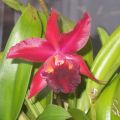


Donate Now
and become
Forum Supporter.

Many perks!
<...more...>


|

10-29-2007, 10:21 AM
|
 |
Senior Member
|
|
Join Date: Aug 2007
Zone: 9b
Location: Gleneden Beach, OR
Age: 49
Posts: 1,309
|
|

Quote:
Originally Posted by kiki-do

I just came across your discussion on "resting your chids" which is all new to me. I've only been orchid growing about one year now. Which orchids, besides den. need resting, and how do you know? If you don't give them water/fertilizer for the bulk of the winter, and only lightly mist every 3 days, won't they start to look poorly?
This is very interesting to me....completely new. I have a variety of orchids and have been watering/fertilizing all along and they all seem fine. Which types and how do you know when they need to rest? Thanks for any help. Kiki-do
|
Just a quickie... In retrospect, looking back at our post I think that one might get the idea that all dens need a winter rest; we need to stress that the majority of dens which "want" a winter rest are those of the Nobile type. As to determining what sort you have, look at the leaves: if they are papery and thin, chances are good that you have a decidiuous dend (which would "want" a winter rest), if on the other hand the leaves are thick or succulent, you most likely have one of the phalaenopsis types or the larger cane types...which will not neccessarily "want" or need a winter rest (though they may appreciate a cool down period to initiate spikes)
Adam
__________________
I've never met an orchid I couldn't kill...
|

10-29-2007, 10:52 AM
|
 |
Senior Member
|
|
Join Date: Apr 2006
Zone: 9a
Location: Spring Hill, FL
Posts: 17,222
|
|

Quote:
Originally Posted by stonedragonfarms

Just a quickie... In retrospect, looking back at our post I think that one might get the idea that all dens need a winter rest; we need to stress that the majority of dens which "want" a winter rest are those of the Nobile type. As to determining what sort you have, look at the leaves: if they are papery and thin, chances are good that you have a decidiuous dend (which would "want" a winter rest), if on the other hand the leaves are thick or succulent, you most likely have one of the phalaenopsis types or the larger cane types...which will not neccessarily "want" or need a winter rest (though they may appreciate a cool down period to initiate spikes)
Adam
|
Hi Adam...
great post 
Many folks are confused on this subject. I'm in the process right now of rearranging the room for the cooler months and with a large collection, it's difficult to figure out some of them. I do want to pass along an idea that Michael Exler gave to me when he visited here recently regarding this subject:
to alleviate the problem of trying to figure out every year which plants get some special treatment, he suggested that a color code is marked on the tag. I immediately saw the value of doing this...next year when the time comes, I'll just have to move the ones that are color coded.
Thanks, Michael 
|

10-29-2007, 11:35 AM
|
|
Senior Member
|
|
Join Date: Apr 2007
Zone: 8b
Location: Southern Oregon
Age: 70
Posts: 6,016
|
|

I love D. cuthbertsonii also, but I can't grow anything that prefers cool temps. My summers are way to hot. It's also described as very challenging to grow in Steven Frownies book Miniature Orchids. I think we need to stick with intermediate so everyone can play. 
As for Dens and winter rests it really is plant specific. I have one I thought would need at least a reduction in water, but it's already pushing out new buds like crazy. Some just need a power nap, others need a full rest, and some don't really sleep at all. It becomes even more complex when you have hybrids between the six different groups. I posted a chart a long tme ago about the dfferent groupings, and their preferred culture. Let me see if I can find it again.
OK found it.
Dendrobium: the major cultural groups, as classified by Rebecca Tyson Northern
Group I - deciduous - intermediate, warm in summer, cool in winter - winter rest - examples: D. nobile, D. chrysanthum, D. wardianum
Group II - deciduous or coriaceous and persistent - intermediate, warm all year - winter rest - examples: D. speciosum, D. aggregatum, D. findlayanum, D. heterocarpum, D. superbum, D. parishii, D. pierardii
Group III - persistent - intermediate, warm in summer, cool in winter - no rest, simply reduce in winter - examples: D. densiflorum, D. fimbriatum, D. thyrsiflorum, D. farmeri
Group IV - persistent - cool all year - short suspension early autum - examples: 'nigro-hirsute' group: D. bellatulum, Pedilonium group: D. secundum
Group V - persistent - intermediate - no rest or short rest after growth - examples: D. antilope (Ceratobium group) V and VI hybrids.
Group VI - persistent - warm - restrict twice - examples: D. phalaenopsis, D. bigibbum, D. superbiens
This of course by no means covers all the species, but at least it's a starting point.
Last edited by quiltergal; 10-29-2007 at 11:46 AM..
Reason: Found Chart
|
|
Currently Active Users Viewing This Thread: 1 (0 members and 1 guests)
|
|
|
 Posting Rules
Posting Rules
|
You may not post new threads
You may not post replies
You may not post attachments
You may not edit your posts
HTML code is Off
|
|
|
All times are GMT -4. The time now is 10:07 PM.
|
































 Hybrid Mode
Hybrid Mode

